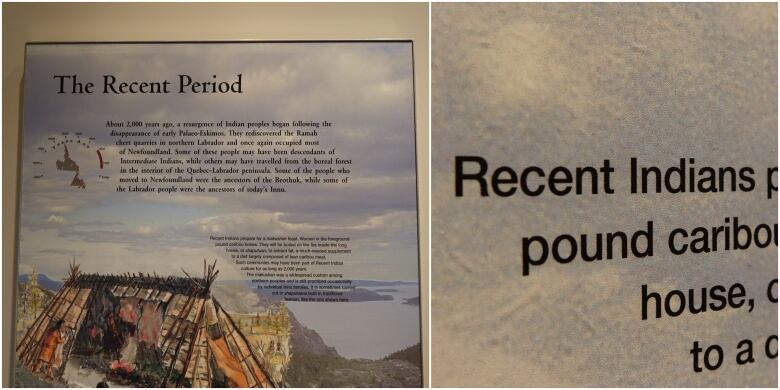The Rooms exhibit referring to Beothuk as 'Indians' unchanged years after promised review
Exhibition is out of date, says department head, but no timeline given for changes

Changes still haven't been made to an exhibit at Newfoundland and Labrador's provincial museum in St. John'sthat describes the Beothuk as "Indians," despite a promise that The Rooms's CEO madealmost five years ago.
"What's the holdup? Get those changes done as promised and get them done sooner than later," said Chief Jasen Benwah of the Benoit First Nation in Cape St. George.
"That's disappointing, really, in 2024 that we're still seeing that, especially from anything that's government-funded and government-owned."
Following a Radio-Canada report on the exhibit in 2019, the provincial museum said it would review several panels on Newfoundland and Labrador's early inhabitants.
The displays, part of a permanent exhibition designed in 2003 and 2004, repeatedly describethe Beothuk and other early Indigenouspeoples as "Indians" or "Indian populations."
"Most permanent collections or permanent exhibits in museums, they have a lifespan of 10 years. This has now been up for 20 years. So that gives you a sense of, yes, it's out of date. Definitely, 100 per centit needs to be updated," said Kate Wolforth, director of the art gallery, museums and visitor experience department at The Rooms.
"Unfortunately it's, you know, the funding and the staff have stayed the same. So we've got to try to do it within our existing resources to make those updates."

Wolforth said the exhibit, in place since The Rooms opened in 2005, displays terminology commonly used by archaeologists at the time.
"We first went to them and what we learned was, yeah, we know these are really outdated terms, [but] we haven't landed as a community on appropriate terms yet."
No timeline for updates
Wolforth said she recognizes several components of the exhibit need to be updated. Some panels are yellowing or difficult to read. In one display case, an artifact described as a tool used by early Labrador Inuit is in fact from Greenland.
Revamping the entire 5,000-square-foot exhibit would likely cost millions, she said, and smaller changes will instead be made gradually.
There is, however,no timeline for that work.

Delays to consultation process
In July 2019, Rooms CEO Anne Chafe promised the exhibit would be reviewed within 12 to 18 months. Wolforth said, however, the museum has an obligation to work in collaboration with Indigenous groups in the province a necessary processbut one that has proven much slower than expected.
"We recognize that updating a gallery in a museum in St. John's isn't necessarily more important than some of the other priorities that communities have," she said, adding that the COVID-19 pandemic has also played a role in slowing down the process.
Wolforth said the museum has made significant strides, hiring an Indigenous cultural liaison to improve programming and foster a better relationship with Indigenous groups, and updating other educational programs. It has also hosted numerous exhibitions featuring local Indigenous artists.
"It is definitely a long-term process and we are really aware that this is an issue that museums across Canada are encountering," Wolforth said.
In 2019, the museum promised that in the interim, signage would be installed explaining the evolution of terms used to describe Indigenous peoples since the exhibit was opened in 2005.
"At that time, the words used here to describe the province's early peoples were considered appropriate," notes a small sign posted next to the main door of the exhibit.
"The Rooms recognizes that language is always evolving. Words once considered acceptable are now outdated and may offend. We are currently consulting with our partners to update this exhibition," reads the sign, posted during the pandemic.
Benwah isn't the only Indigenous leader to have criticized the exhibit.
In 2019, then Miawpukek chief Mi'sel Joe said The Rooms, an institution with a mandate to inform people on the province's history, was "further educating people [that] it's OK to use that kind of language."
"It matters in the sense that we're teaching [people] how to look at us in a proper way," he said. "The language and the racism and the prejudice that's been there for years is part of that word, 'Indian.'"
Download ourfree CBC News appto sign up for push alerts for CBC Newfoundland and Labrador.Click here to visit our landing page.













_(720p).jpg)


 OFFICIAL HD MUSIC VIDEO.jpg)
.jpg)



























































































